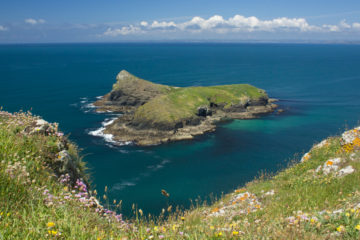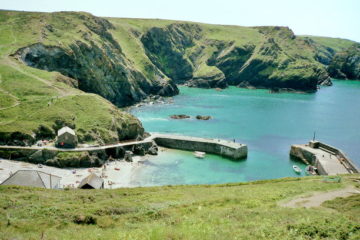Land’s End is an excellent place to take the club boats for a long weekend. The range of diving available means that all levels of diver can be accommodated, and most dive sites can be geared towards both the inexperienced and the more advanced.Historically, accommodation is provided by Tower Park Campsite (£10-£15 per tent per night depending on the season) in St Buryan, a small village a few miles from the launching slip at Porthgwarra. St Buryan boasts a small supermarket and a few reasonable pubs which do good food.
Porthgwarra is a steep slip that is pretty much inaccessible for RIBs but is perfect for the club boats. It costs £10 a day to launch from there and permission has to be obtained from the harbour master. It is also possible to leave the boats tied down on the slip using the rings on the right hand side (looking seawards). Care needs to be taken as Porthgwarra beach is quite popular with holidaymakers during the summer. At the top of the slip is a small teashop providing excellent pasties and cream teas. The slip is also very steep down to the beach and so it is hard work carrying boats and kit up and down it every day. It is recommended that you have between 10-12 divers on this trip as many hands make light work!
The Diving
Seggy Rock
Seggy Rock lies just to the east of Logan Rock and is a very rewarding dive. The south-east side of the rock drops down to about 15m, and further out consists of large bouldery slopes with patches of coarse sand. Between the boulders are plenty of swimthroughs and tunnels which can be great fun to to dive through. Here the depth can get down to about 25m. Due to the sandy patches, the dives are usually very bright with vis of 8-10m not uncommon. The life is prolific boasting shoals of cuckoo wrasse, ballan wrasse, pollack and poor cod, as well as loads of colourful jewel anenomes and squidgy things that have latin names. The western side of the rock is not as interesting but still can provide a pleasant dive. It is shallower here (about 12m) with much more kelp. If conditions allow, a full circumnavigation of the rock is well worth it. Seggy Rock is diveable at all states of the tide.
Logan’s Gully
Logan’s Gully lies off the south west tip of Logan Rock and is a very easy dive. Mostly at 10m, although depths of 15m are possible, the coarse sand settles quickly allowing fantastic visibility, this dive is great for beginner photographers with plenty of life on show. Time can be spent observing the predatory nature of the pollack rounding up sand-eels before fixing themselves a tasty lunch. Logan’s gully is diveable at all states of the tide.
GPS: 50.02.4N, 05.38.25W
The Runnel Stone
The Runnel Stone is a granite pinnacle situated about a mile south of Gwennap Head, Cornwall. Rising from 35m or more to within 6m of the surface it is home to a profusion of marine life and pelagic shoals can often be seen circling its upper regions. Several shipwrecks lie near the rock, including that of the 6,000 ton City of Westminster. This, and the presence of interesting reefs and marine life, make it a popular diving location. The City of Westminster is a beautiful wreck in which to rummage and some spectacular life-covered walls for those who prefer marine biology. Often excellent visibility of 20m and above.
To find the City of Westminster, go to the bell buoy 100m off shore and line up the two cones on the cliff tops above Gwennap Head. From the bell buoy follow this line in. The depth will jump from 35m to 15m, then to about 6m before dropping again to 20m. The 6m point is right above the rock. Be careful of the ground swell. If dropping a shot, it is best to steer just west of Runnel Stone and drop it onto the wreck at 20-25m, letting the line drag back across the rock.
GPS: 50.01.33N, 05.40.33W
Wolf Rock
Wolf Rock lies about 7 miles south of Porthgwarra and can only be dived if the conditions allow. Wolf Rock rises up from a depth of 60 m to the surface, where stands the famous lighthouse (now un-manned). It earned its name from the sound the wind makes when it rushes around the rock, howling like a wolf. Harsh and exposed this is a daunting dive site even for old hands at diving. 7 tidal currents are reputed to meet here, which makes it an unpredictable area, so it is not a site for the inexperienced or faint-hearted. The north-west side of the reef drops off sharply into the depths and is spectacular to say the least. The visibility can be exceptional and divers tales tell of 30m+ on a clear days. Slack water at Wolf Rock is not obvious and it is more a case of when the conditions are good enough to get there. With an obvious current running, there is no time to mess about on the surface. The boat runs in, engine in neutral, divers over the side and down to 10 metres as fast as possible. At 10m you can relax and find your buddy. Not a normal start to a dive, but in practice the only practical way to cope with such a dive site in a current and ground swell.
Longships Lighthouse
This is possibly the best dive in Cornwall. It is often overlooked as it can be difficult to get to, however, it is a must if conditions allow. Longships is a large group of rocks 2 km west of Land’s End. Starting off on the west side of the lighthouse in 10m, the vis can get up to 15m with sandy areas surrounded by 6m high sheer walls and a lot of life. Basking sharks have been seen here in recent years. Down at 30m there are the fabled canyons that make Longships such a dramatic dive. Care needs to be taken as the currents can be ferocious and experienced boat handlers are needed. Again, it is rumoured that 7 currents meet at Longships, so it is never really slack. Great care needs to be taken.


0 Comments